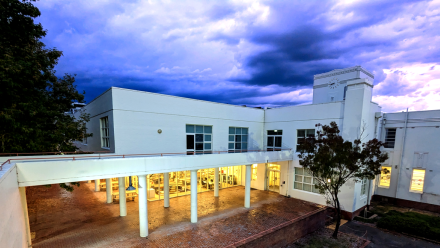All ANU theses digitised – the 1950s
ANU Library has recently finished digitising our entire collection of ANU theses, and making them available online through the Open Research repository. This will see research once largely hidden from view being exposed to people from all over the world.
To celebrate, we are taking a look at a selection of theses that you can now access online.
Let's look at some early ANU theses from the 1950s!
1953
Susan Liesching was the first female graduate from ANU in 1954.
1954
Peter Worsley was a social anthropologist turned sociologist, who is noted for introducing the term “third world” into English, as a means of describing developing nations.
1955
Edward Hannan was a distinguished Australian statistician credited as co-discoverer of the Hannan-Quinn information criterion. At ANU, Edward was a Fellow in Statistics from 1954-1958 and Professor of Statistics between 1959-1986. Following his retirement, the ANU appointed him an Emeritus Professor.
Joseph Gani was a Senior Fellow in Statistics at ANU from 1961-1964, a Professor in statistics in a number of overseas universities and Chief of the CSIRO Division of Mathematics and Statistics. Joe and his lifelong friend Ted Hannan (see above) became the first PhD students in statistics at ANU – both completing their theses under supervisor of Pat Moran.
1956
Noel Barnard was the first graduate in Chinese history at ANU. He was a world authority in the field of early Chinese history and archaeology, in particular metallurgy. His focus was on the interpretation of inscriptions, especially those found on the bronze vessels of the Zhou dynasty.
Russel Ward was an Australian historian, best known for his examination of the development of the ‘Australian character’ in his influential and controversial book The Australian Legend, which was in part written in his thesis at ANU.
1957
Marie Reay was a leader in the anthropology profession, and was instrumental in expanding the fields of Australian anthropology, including the study of women and race relations. While studying her PhD, Reay became the first female anthropologist to go into the Kuma region of New Guinea.
Each year the School of Culture, History and Language, College of Asia & the Pacific offers a prize known as the Marie Reay Prize. This assists students in the Anthropology Program with the costs of conducting ethnographic fieldwork during their PhD research. The Marie Reay Teaching Centre opened in Kambri this year.
1958
Jeremy Beckett carried out long term field research on Australian Aborigines and Torres Strait Islanders. Dr Beckett wrote a number of books about Indigenous history, including The Two Rainbow Serpents Travelling. He was called as an expert witness at the Supreme Court hearings in the Mabo case.
Trevor Ophel was an Emiratus Professor and Visiting Fellow in the Department of Nuclear Physics at ANU. Along with John Jenkin, Ophel wrote a history of the ANU Research School of Physical Sciences, Fire in the Belly, which was published in 1996 for the university’s 50th anniversary.
David White was a renowned member of the Australian and international scientific communities, who was a pioneer in the field of Virology. David made major contributions towards elucidating the molecular biology and immunology of the influenza virus during his long career.
1959
Donald Gemmell was an experimental physicist whose work spanned across many fields. He produced important research results in nuclear, molecular, atomic, solid-state, x-ray, astro and biophysics – not to mention chemistry. He was one of the first scientists to use computers to assist in controlling, recording and analysing experiments.
You can search and browse to find a wealth of research in the ANU Library theses collection.


